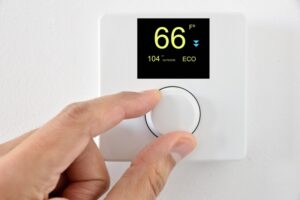
Have you ever wondered when you looked at the thermostat for your house if you could make all the rooms even colder than the lowest reading? On most thermostats, the lowest setting possible is 60°/65°F. But could the AC make the house even colder than that? What are the limits of the cooling power of an air conditioner?
We don’t think this is a frivolous question, and the answer isn’t just trivia. Understanding the limits of your home’s air conditioning system can make it easier for you to know how much you can push it and when you should rein back. Below we’ll get into how cool the AC can make your house—and how oversized systems can struggle with temperature regulation.
What Is the AC Temperature Differential?
Because the thermostat creates a lower limit on cooling the house at either 60° or 65°F, you can’t get the temperature lower than that. The thermostat controls when the AC turns on and off, and if you set the thermostat to the lowest temperature, the thermostat will signal to the AC to cycle down when it reaches that temperature.
However, that isn’t the actual limitation on an air conditioner. This isn’t about how cool the AC can make the house, but the difference in how much it can lower the temperature compared to the outside. This is called the temperature differential: how many degrees difference can the air conditioner make?
Your air conditioner, as with all other residential central ACs, has a temperature differential of 20°. This means that at most it can lower the indoor temperature by 20° compared to the outside.
Summer Cooling Limits: Understanding Your AC’s Capabilities
Is a 20° temperature differential enough for comfort? Well, if you’ve already spent a few summers with your current air conditioning system, you’ll know the answer is yes. (If it isn’t, we hope you got a new air conditioner! An AC that cannot deliver basic comfort to a house is either broken or is too underpowered for the space.)
It’s easy to show why a 20° change is usually more than enough for comfort. Here in Atlanta, our hottest month is July, where the average high during the day is 89°F. An air conditioning system can lower that to 69°F, and that’s a low temperature—most people won’t find that comfortable. We recommend 78°F to help save energy, which is easily in reach with a 20° temperature differential. Even a 98°F day (which is rare) is in the 20° range.
How Humidity Affects Your AC’s Cooling Efficiency
We haven’t mentioned humidity, which makes the days feel hotter, and this is where an AC may run into limitation issues. High humidity can make an 89°F day feel like its 96°F, which is still something an AC can deal with. But we advise customers look into how humidity affects indoor comfort and AC performance to help get control over high humidity; otherwise they might push their air conditioners too hard against their limitations. When an AC is pushed past its temperature differential’s limits, it will just run continuously and waste power.
If you’re looking for help with an air conditioner in Conyers, GA that can’t handle the summer heat, or you’re interested in a dehumidifier, reach out to our professionals. You might also benefit from reviewing your thermostat settings for an energy-saving summer, especially if your current setup isn’t maximizing efficiency.
Call Premier Heating & Air and Experience the Premier Difference! We’ve been Family-Owned & Operated Since 2001.

